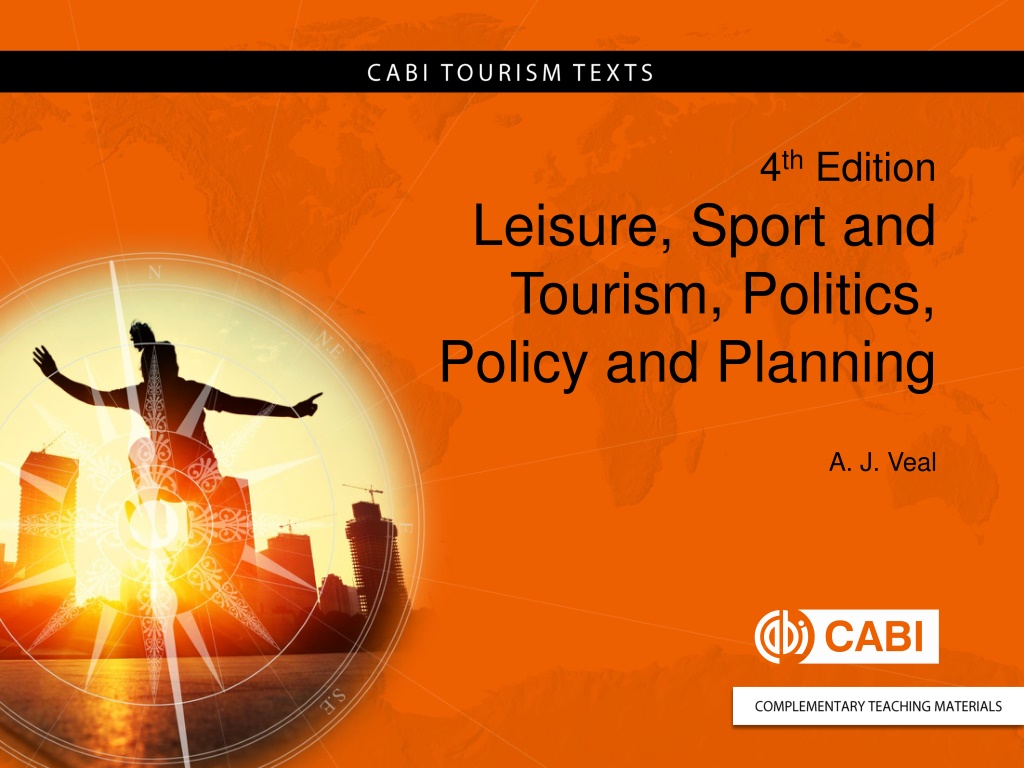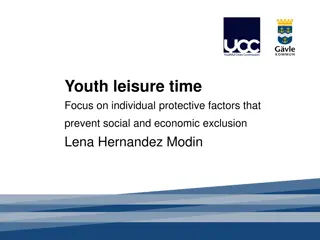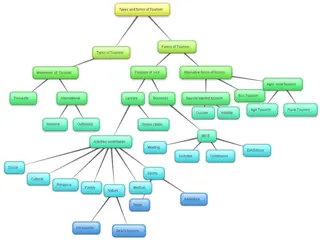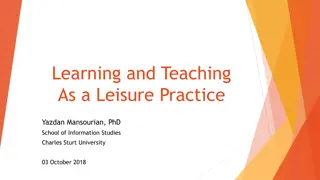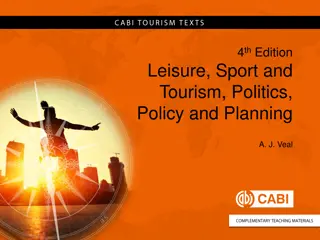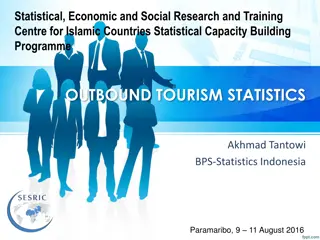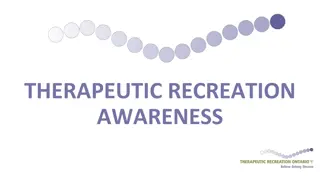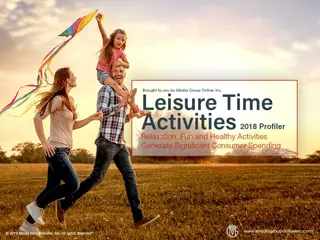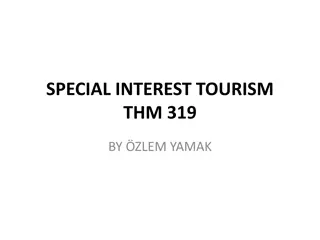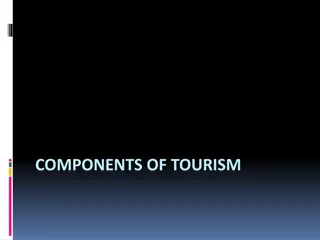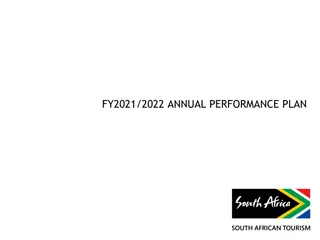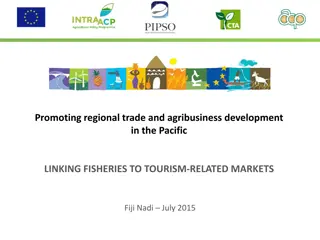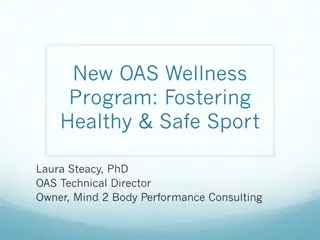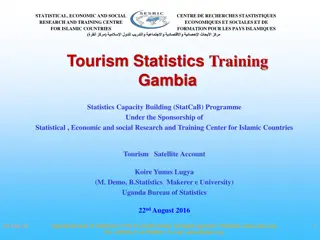Diversity in Leisure, Sport, and Tourism: Policies and Challenges
Gender, socio-economic status, ethnicity, disability, and age play significant roles in shaping participation patterns in leisure, sport, and tourism. While recent research has addressed gender disparities, women still face barriers like childcare responsibilities and limited access to facilities. Men also encounter challenges, such as lack of role models and societal expectations. The needs of specific groups, including women, girls, men, and boys, must be recognized and addressed in policy and planning efforts to promote inclusivity and diversity in these sectors.
Download Presentation

Please find below an Image/Link to download the presentation.
The content on the website is provided AS IS for your information and personal use only. It may not be sold, licensed, or shared on other websites without obtaining consent from the author. Download presentation by click this link. If you encounter any issues during the download, it is possible that the publisher has removed the file from their server.
E N D
Presentation Transcript
4th Edition Leisure, Sport and Tourism, Politics, Policy and Planning A. J. Veal
CHAPTER 17 Policy and Planning for Particular Groups Leisure, Sport and Tourism, Politics, Policy and Planning, 4th edition, Veal, 2017, CABI Tourism Texts
Outline Introduction Gender Socio-economic status Ethnicity Disability Age Leisure, Sport and Tourism, Politics, Policy and Planning, 4th edition, Veal, 2017, CABI Tourism Texts
Gender For many aspects of leisure/sport/tourism, males and females have different behaviour patterns, attitudes and constraints. Early research was considered gender blind .* Recent research has sought to correct this. But arguably not as true for Australia; see Veal, A.J. (2011) Leisure participation patterns and gender: the survey evidence on Australian adults. Annals of Leisure Research 14(2 3), 107 128 Leisure, Sport and Tourism, Politics, Policy and Planning, 4th edition, Veal, 2017, CABI Tourism Texts
Women and girls In an equal society there would be few special women s needs , but meanwhile key issues include: childcare responsibilities lack of childcare services at leisure facilities after-dark security access to facilities Research highlights women s lower participation in sport: cultural expectations poor access to facilities traditionally dominated by men s organizations lack of media coverage There have been policy responses from organizations such as Sport England. In other sectors, women s participation levels are similar to, or higher than, those of males (see Veal, 2011): e.g. arts, informal outdoor recreation, tourism Leisure, Sport and Tourism, Politics, Policy and Planning, 4th edition, Veal, 2017, CABI Tourism Texts
Men and boys A number of issues have arisen in recent years in relation to boys: whether risk-reduced approaches to physical activities meets boys developmental needs lack of male role models at primary school level in families where parents are separated/divorced, the father is seen only as being associated with leisure In relation to men: the fathering role and leisure traditional and stereotypical masculinities and leisure role expectations Leisure, Sport and Tourism, Politics, Policy and Planning, 4th edition, Veal, 2017, CABI Tourism Texts
Gays/lesbians Leisure of gays/lesbians emerged in recent years as a focus of research. While there are major general public policy issues in regard to rights and discrimination, few implications for traditional public leisure provision areas have been highlighted in the research literature. Leisure, Sport and Tourism, Politics, Policy and Planning, 4th edition, Veal, 2017, CABI Tourism Texts
Socio-economic status Primarily, occupational status of those in employment and their dependants Sometimes referred to as class or social class or socio-economic group (SEG) Correlated with wealth/income and other factors education and general lifestyle Leisure aspects revealed, in part, in household expenditure data (see Table 17.1) note how differences influenced by household size Leisure, Sport and Tourism, Politics, Policy and Planning, 4th edition, Veal, 2017, CABI Tourism Texts
Household expenditure, UK, 2007 (Table 15.1) HOUSEHOLDS, /week Ratio of top to bottom 7.1 Bottom 10% Average Top 10% Household expenditure 138.1 459.2 986.7 No. in household 1.2 2.4 3.1 2.6 PERSONS, /week 2.6 Leisure Food/drink (non- alcoholic) Clothing/footwear 28.08 44.08 73.61 20.42 20.04 23.58 1.2 5.25 9.17 16.23 3.1 Housing/household 43.33 34.38 42.29 1.0 Transport/communication 17.83 30.67 57.87 3.2 Other 26.25 52.96 104.71 4.0 Total expenditure 143.67 191.33 318.29 2.2 Leisure, Sport and Tourism, Politics, Policy and Planning, 4th edition, Veal, 2017, CABI Tourism Texts
Socio-economic status (contd) Planning sometimes based primarily on SES i.e. priority given to areas with low SES This is a blunt instrument, because: areas with high proportions of people in deprived categories may not have a majority in such groups evidence of increased participation resulting from such policies is limited people on low income may have other priorities than leisure provision may neglect public good policies, which apply to all Leisure, Sport and Tourism, Politics, Policy and Planning, 4th edition, Veal, 2017, CABI Tourism Texts
Ethnicity Ethnic group: a group with a common culture so everyone belongs to an ethnic group, which may be a majority or minority Policies often directed at enabling particular minority groups to participate Current patterns of participation present a mixed picture Leisure, Sport and Tourism, Politics, Policy and Planning, 4th edition, Veal, 2017, CABI Tourism Texts
Participation in sports and exercise: ethnic minority groups, England, 2004 (Table 17.2) Male Female % participating at least once a week Black Caribbean 39 27 Black African 35 20 Indian 26 21 Pakistani 25 13 Bangladeshi 22 11 Chinese 39 27 Irish 33 29 General population 33 25 Leisure, Sport and Tourism, Politics, Policy and Planning, 4th edition, Veal, 2017, CABI Tourism Texts
Arts/culture attendance/participation by ethnicity, England, 2015 2016 (Table 17.3) White Black/minority groups % of persons aged 16+ participating at least once in year Arts attendance 77.4 66.3 Heritage 74.7 56.1 Museum/gallery 52.0 48.3 Public library 31.8 49.3 Digital 36.5 35.8 Leisure, Sport and Tourism, Politics, Policy and Planning, 4th edition, Veal, 2017, CABI Tourism Texts
Disability Disabilities include: mental illness physical disability, including: deafness dumbness blindness nervous/musculo-skeletal illnesses such as diabetes, asthma etc. Deinstitutionalization people with severe disabilities previously living in and catered for by institutions now live in, and should be catered for by, the community Leisure, Sport and Tourism, Politics, Policy and Planning, 4th edition, Veal, 2017, CABI Tourism Texts
Disability (contd) A human rights approach, supported by: UN declarations (see Ch. 4) UK Disability Discrimination Act 1995 Australian Disability Discrimination Act 1992 Places an obligation on leisure/sport/tourism organizations to ensure access for people with disabilities However, even with legal backing, some organizations are slow to comply. A market approach notes that people with disabilities are an increasingly significant market especially given the association of some disabilities with the ageing process. Leisure, Sport and Tourism, Politics, Policy and Planning, 4th edition, Veal, 2017, CABI Tourism Texts
Age-related Generations Children Youth Elderly Leisure, Sport and Tourism, Politics, Policy and Planning, 4th edition, Veal, 2017, CABI Tourism Texts
Summary of generations (Table 17.4) Generation Born Age in 2016 Oldest generation 1891 1926 90+ Lucky generation 1927 1946 70 89 Baby boomers 1946 1966 50 69 Generation X & Y 1966 1986 30 49 iGeneration/Millennials 1986 2010 6 29 Next generation 2011 2025 0 5 Leisure, Sport and Tourism, Politics, Policy and Planning, 4th edition, Veal, 2017, CABI Tourism Texts
Children Concerns about lack of physical activity (and poor diet) and increasing sedentary (screen-based) activity resulting in: many children being overweight/obese future health problems Leisure-related data ambivalent Leisure, Sport and Tourism, Politics, Policy and Planning, 4th edition, Veal, 2017, CABI Tourism Texts
Young people (514): leisure participation, Australia, 200309(Table 17.5) 2003 2006 2009 % participating at least once in year, outside of school hours Play musical instrument Singing Dancing Drama Swimming Soccer Australian rules football Netball Tennis 1+ organized sport Bicycle riding Reading for pleasure Watching TV/DVD Other screen-based 16.8 4.6 12.4 4.3 16.6 13.4 7.3 9.1 8.6 61.5 98.2 74.8 98.2 na 19.5 5.5 12.5 4.5 17.4 13.2 7.5 8.5 7.3 62.8 97.4 74.5 97.4 na 19.9 6.1 14.3 4.7 18.5 13.2 8.6 8.4 7.9 63.1 97.4 72.2 97.4 83.2 Leisure, Sport and Tourism, Politics, Policy and Planning, 4th edition, Veal, 2017, CABI Tourism Texts
Youth Youth covers early teens to early 20s Provision for young people is one of the key historical origins of public leisure services linked to the prevention of juvenile crime. Current concerns with: drug use excessive screen-based leisure (as opposed to physical activity) Leisure, Sport and Tourism, Politics, Policy and Planning, 4th edition, Veal, 2017, CABI Tourism Texts
Youth (contd) There is considerable research on youth and leisure, subcultures, etc. But it quickly becomes dated with changing lifestyles Traditional youth facility is the youth club : often caters only for a minority unlike adult provision, typically there is only one youth club in any given community Leisure, Sport and Tourism, Politics, Policy and Planning, 4th edition, Veal, 2017, CABI Tourism Texts
The elderly Ageing of the population is a worldwide phenomenon, especially in developed economies see Fig. 13.1. Changing profile: fitter, due to improved diet etc. wealthier due to superannuation including younger people due to early retirement Community benefits from providing facilities for the elderly: improved health, mental and physical Leisure, Sport and Tourism, Politics, Policy and Planning, 4th edition, Veal, 2017, CABI Tourism Texts
The elderly (contd) The elderly are able to make use of facilities in off- peak times or seasons. Continuity theory suggests that many elderly do not take up new leisure activities after retirement; suggesting it is desirable to develop a leisure repertoire earlier in life. Leisure, Sport and Tourism, Politics, Policy and Planning, 4th edition, Veal, 2017, CABI Tourism Texts
